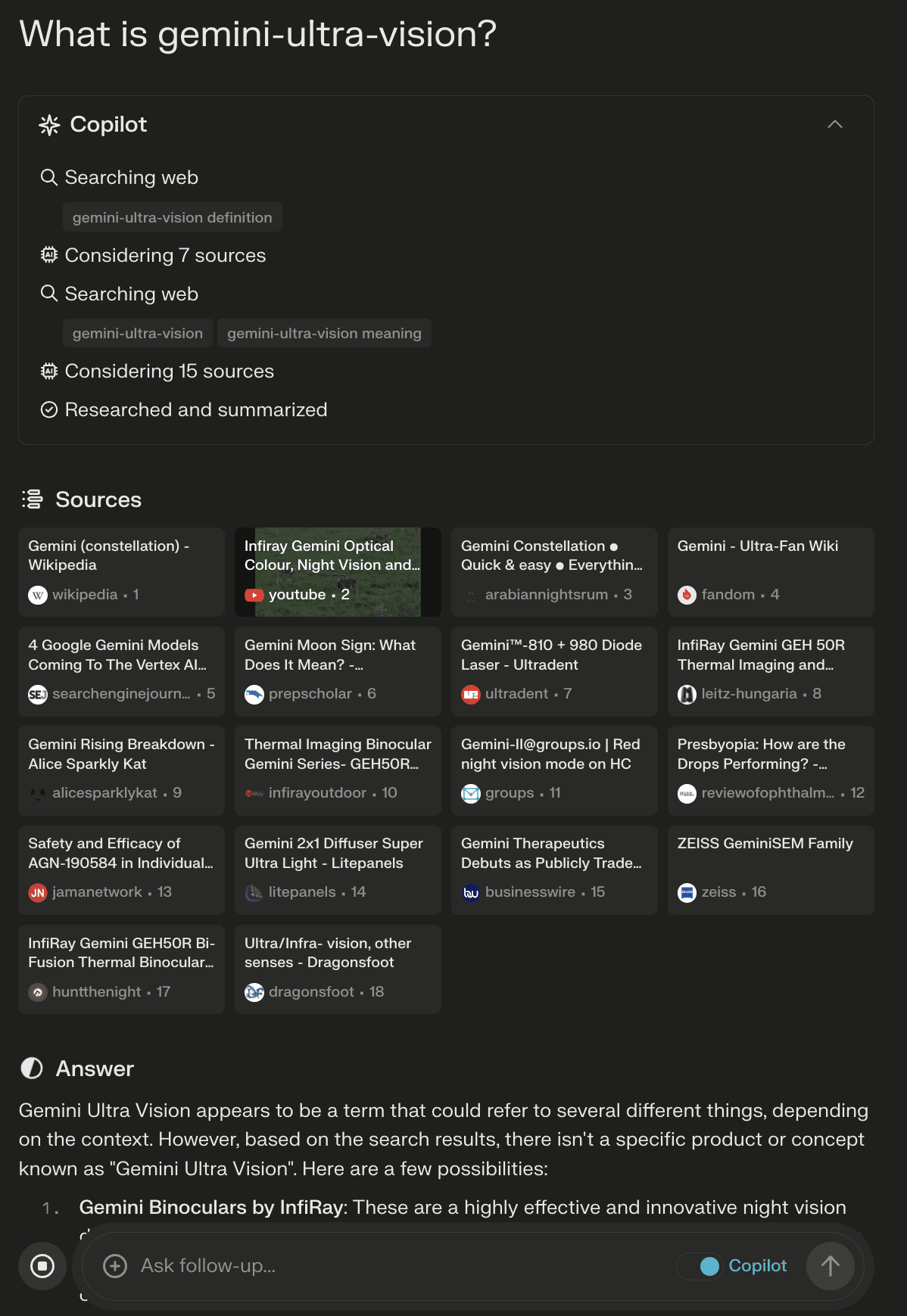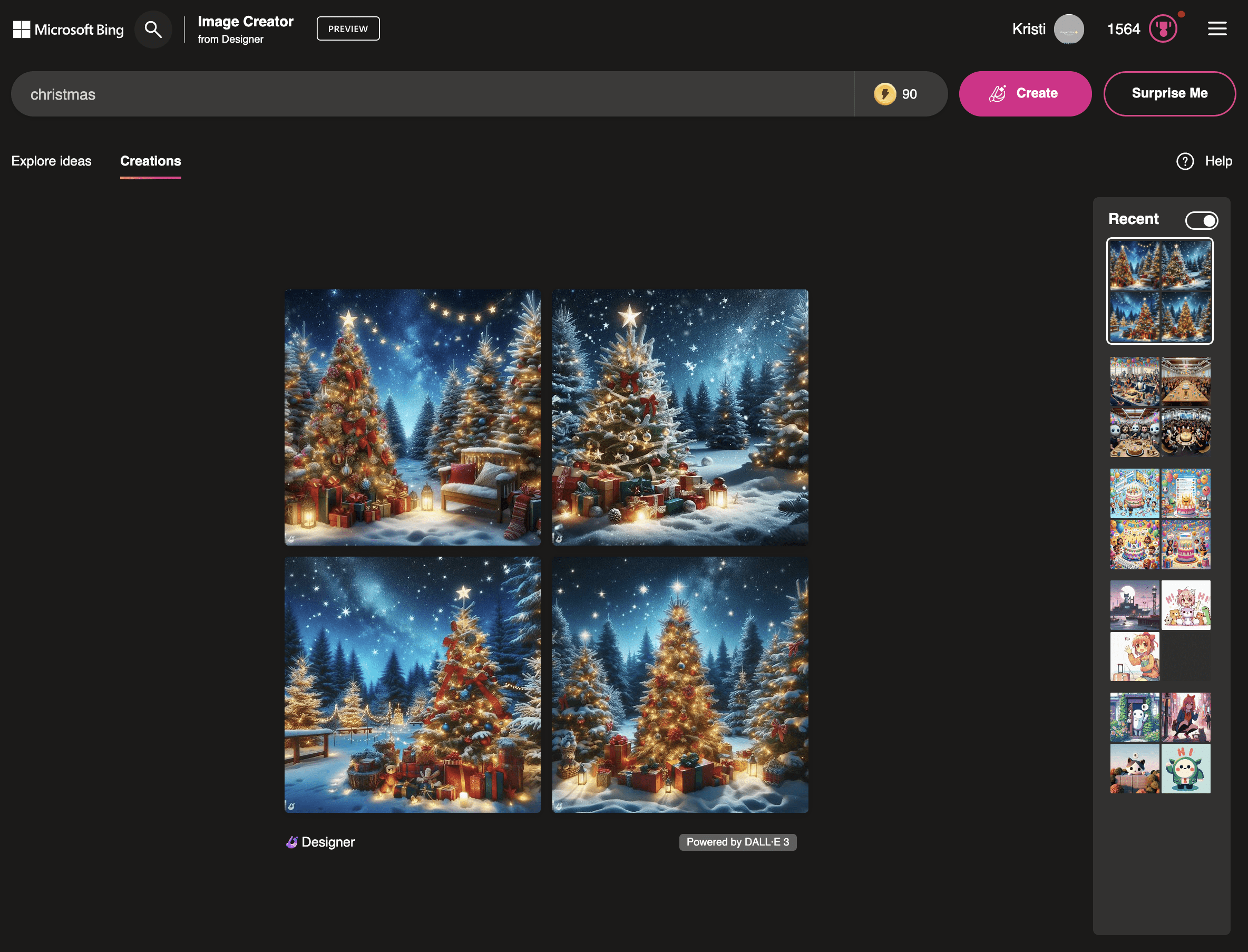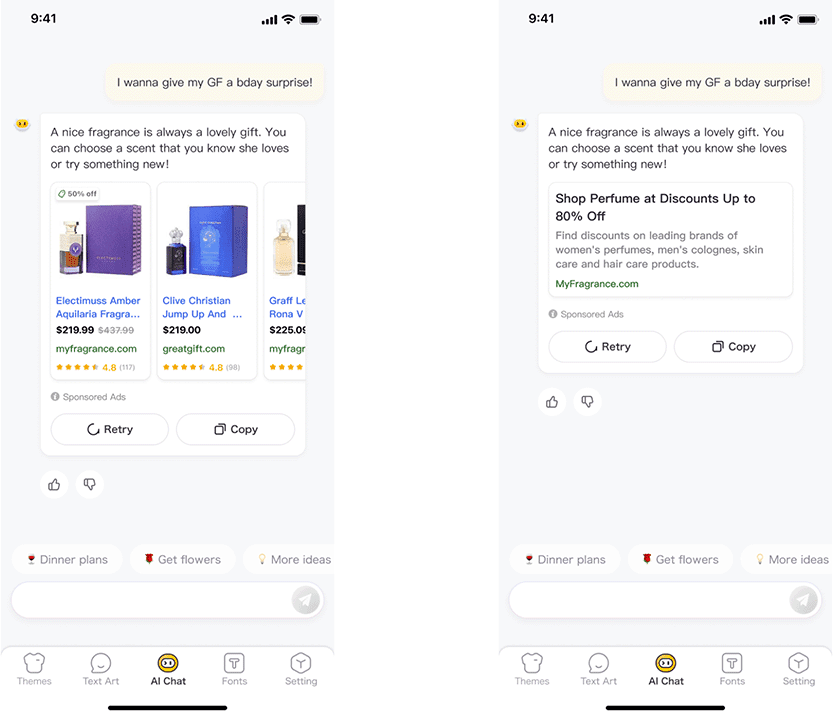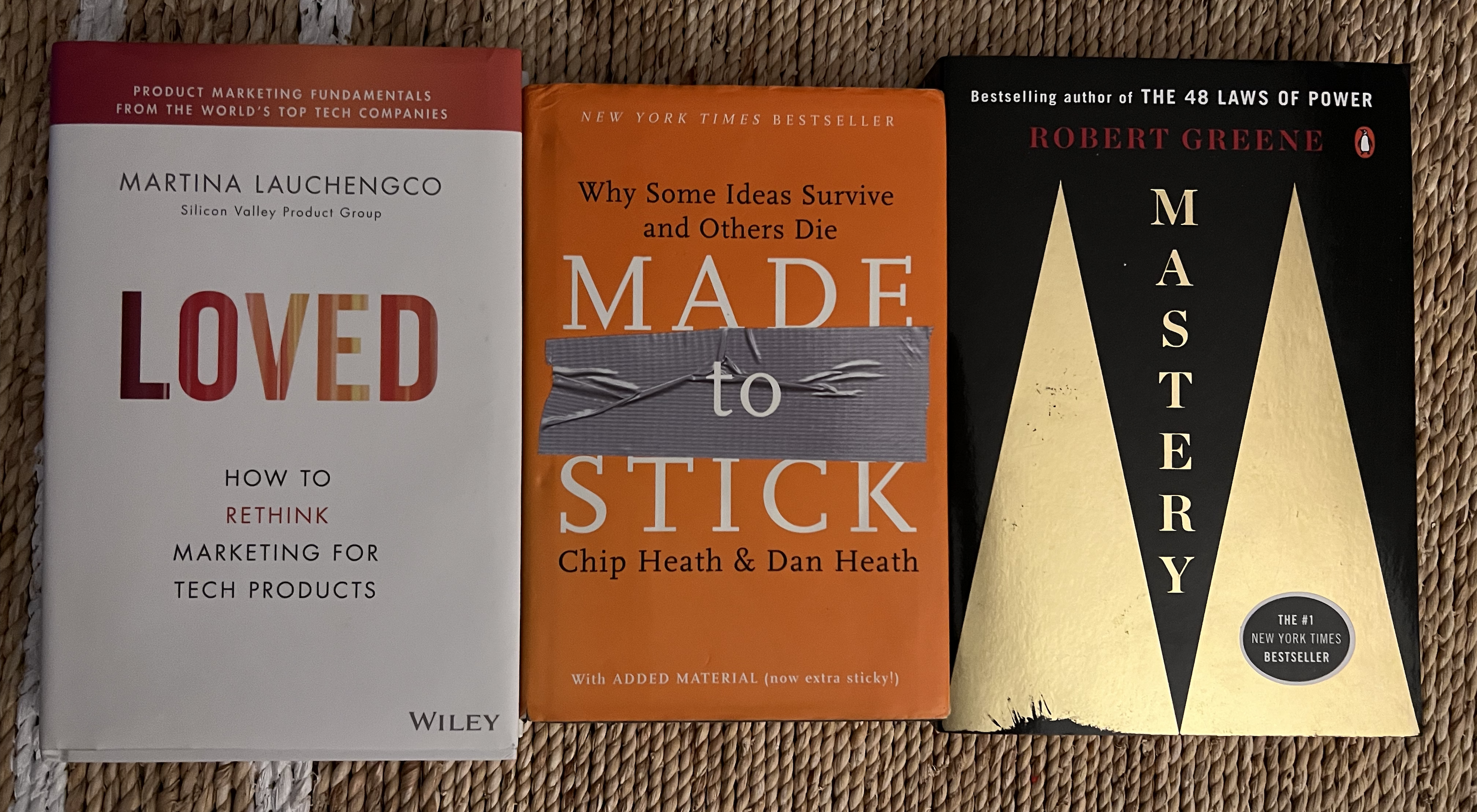4 TikTok Analytics Tools That Do the Math for You
Table of Contents
Ah, TikTok. What started as the domain of teenagers doing their teenager thing has become an important marketing channel – and not just for those marketing to teens. The platform now has more than a billion monthly users, and nearly a third of them are over 35. That means TikTok has become serious business for brands and organizations of all shapes and sizes.
TikTok analytics provide the information you need to take your TikTok strategy seriously, with insights into what works and what doesn’t for your business.
Before we jump into the details, here’s a quick overview of everything you need to know:
What is TikTok analytics?
TikTok analytics are tools that allow you to track your performance on TikTok. They provide insights into which videos are seeing the most activity. On a deeper level, they help guide your TikTok marketing strategy, as you come to understand what resonates best with your audience.
Regularly reviewing the most important metrics for your TikTok account will allow you to grow strategically, rather than simply hoping for the best.
27 key metrics to track on TikTok
TikTok account metrics
- Video views. The total number of times your account’s videos were viewed over a given period.
- Profile views. The number of times your profile was viewed over the selected period. This TikTok metric is a good indication of brand interest. It measures the number of people who liked your video enough to check out your profile, or people who search for your brand on the platform.
- Likes. The number of likes your videos received in the selected date range.
- Comments. The number of comments your videos received in the selected date range.
- Shares. The number of shares your videos received in the selected date range.
- Content frequency. The number of videos you shared in the selected date range.
TikTok content metrics (for individual videos)
- Post views. The number of times a TikTok video has been viewed.
- Post likes. How many likes a post has received.
- Post comments. How many comments a post has received.
- Post shares. The number of times the post has been shared.
- Post engagement rate: Calculated as [(Number of likes + Number of comments + Number of shares + Number of content clicks in videos) / Number of viewers] * 100. Tip: Don’t like math? Hootsuite Analytics calculates engagement rate for you.
- Post average watch time. The average amount of time people spent watching this video.
- Video completion percentage. The number of times the video has been watched in full, as a percentage of viewers (identified in TikTok analytics as “watched full video”)
- Video reach. The total number of individual users who watched this video.
- Traffic sources. How people fi=ound your video. Traffic sources include the For You feed, your profile, the Following feed, sounds, searches, and hashtags.
- Video views by region. This section displays the top locations of viewers for the post. If you created a post or marketing campaign for a specific location, this is how to tell if it reached them.

#1 Analytics Tool for Growth
Beautiful reports. Clear data. Actionable insights to help you grow faster.
TikTok follower metrics (and demographics)
- Follower count: How many followers you have, total, at this moment in time.
- Net new followers: Total increase or decrease in your follower count during the selected time period.
- Gender distribution. A breakdown of the stated gender identities of your followers. While this isn’t necessarily critical information, any insight into your audience can help you build better audience personas.
- Country distribution. Where your followers are from, ranked by country. (Identified in TikTok Analytics as “Top Territories.”) Keep these places in mind if you’re looking to localize content and promotions.
- Follower activity. The times and days that your followers are active and scrolling on TikTok. Hootsuite uses this data to recommend best times to post based on your preferred goal.
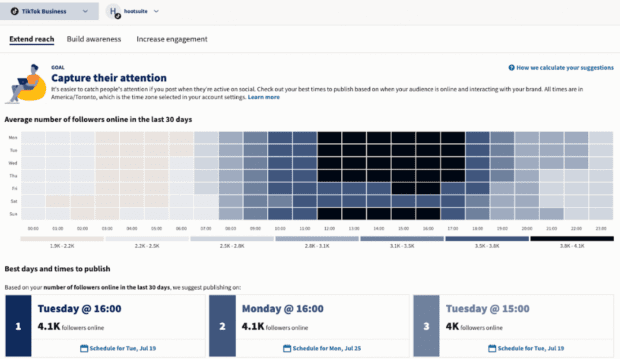


TikTok Live metrics
- Total views. The total number of viewers present during your live videos in the selected date range.
- Total time. The total time you spent hosting live videos in the selected date range.
- New followers. The number of new followers gained while hosting a live video in the selected date range.
- Top viewer count. The peak number of users who viewed your live video at one time in the selected date range.
- Unique viewers. The number of users who viewed your live video at least once (in this stat, a viewer is only counted once, no matter how many times they replay the video).
- Diamonds. When you host a live video (and you’re 18+), viewers can send you virtual gifts, including “Diamonds.” You can exchange these diamonds for real money through TikTok—more info on that here. This stat shows how many diamonds you have earned in the selected date range.
4 TikTok analytics tools for 2024
First things first: Wondering how to turn on analytics on TikTok? To use a TikTok analytics tool, you’ll need to have a TikTok Business account. It’s free to switch. Just follow these steps:
- From your TikTok profile page, open the Settings and privacy tab (the three lines in the top right corner).
- Tap Manage account.
- Under Account control, choose Switch to Business Account.
1. Hootsuite
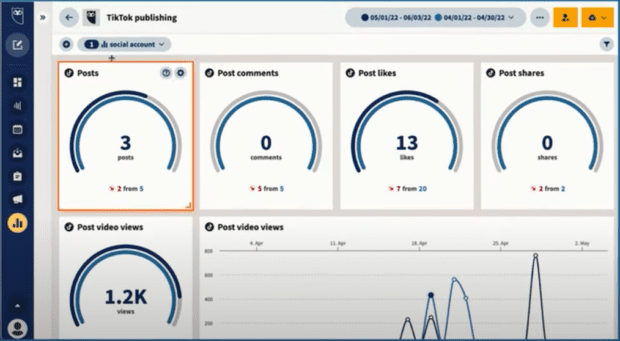


Hootsuite offers robust TikTok analytics reporting, with customizable reports and graphs that allow you to understand your current performance at a glance. If you want to dive into the details, you can do that too. Perhaps most importantly, Hootsuite allows you to analyze TikTok data for any timeframe you choose, whereas TikTok’s native tools are capped at 60 days.
The handy thing about Hootsuite’s highly customizable TikTok reports is that you can get as much or as little detail as you want. And you can create multiple reports for different shareholders with just a few clicks – so you can prove the success of your TikTok content strategy to senior stakeholders without having to walk them through every single stat.
You can also directly compare two time periods, so you can more easily identify trends.
Since most social marketers use TikTok as part of a multi-platform social strategy, it’s important to consider your TikTok insights in the context of your overall social performance. Hoostuite makes it easier to compare TikToks and Instagram Reels side-by-side, for example, so you can understand which is getting more traction.
Knowing where each platform fits into your social plan allows you to allocate resources more effectively and improve your entire social strategy, not just your TikTok results.
2. TikTok’s built-in tools
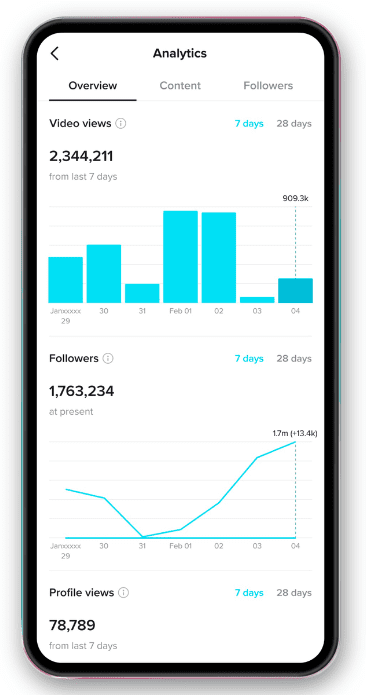


Source: TikTok
You can check your TikTok analytics for free using their native tools on your computer as well as within the mobile app. However, you can only download your data from the desktop dashboard. Here’s how to check TikTok analytics both ways:
- On mobile: From your account page, tap the three dots icon and select Creator tools. Tap Analytics and you’re good to go!
- On desktop: Navigate to tiktok.com and log in. Click your profile picture and choose Business Suite from the dropdown menu. This takes you directly to the Analytics page.
3. Sprout Social
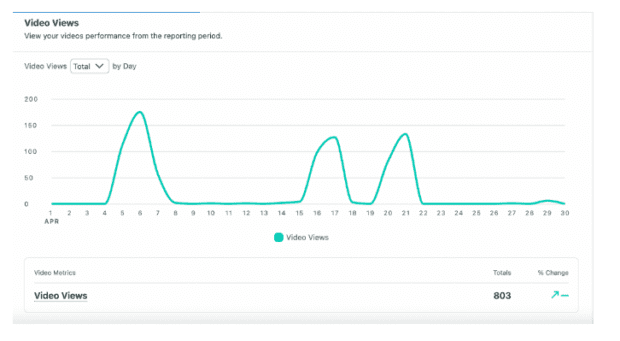


Source: Sprout Social
Sprout Social offers a TikTok Analytics tool that provides access to many of the metrics above. It has graphical reports that make it easy to understand your TikTok activity. Like Hootsuite, it offers data beyond TikTok’s 60-day limit, but there are fewer customization options. It also offers recommendations on the best time to post, but they are not customizable by goal.
See how Sprout Social compares to Hootsuite.
4. Countik
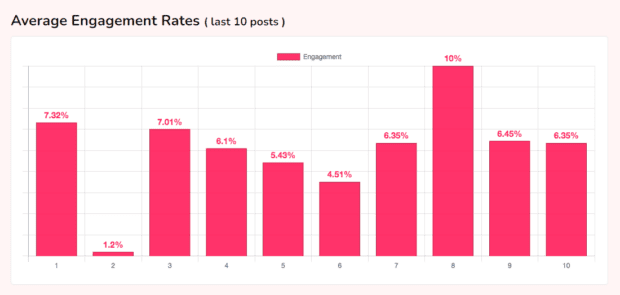


Source: Countik
Countik is a free TikTok analytics tracker that lets you see insights for the most recent posts of any TikTok account. Just enter the Tik Tok handle in the search bar and click the magnifying glass.
You’ll get a lot of useful information, including average engagement rates, likes views, comments, and shares. You’ll also see the account’s most-used hashtags and mentions.
This is definitely a useful tool to research competitors and collaborators, but it does have significant limitations. The charts only include information on the last 10 posts, and the per-post analytics only include the most recent 20 posts.
How to use TikTok analytics tools for best results
Check in on a regular basis
While things move fast in general online, they move at light speed on TikTok. This is not a platform where you can afford to tune out of reporting for a few weeks.
Checking in regularly allows you to understand how TikTok user behavior is changing in near real time so you can adapt your strategy on the fly.
Hootsuite can keep you on track with your TikTok analytics tracking by automatically sending you (and other stakeholders) reports on a pre-set schedule, so the data comes right to your inbox.
Keep an eye on competitors – and potential collaborators
Within TikTok’s native analytics tool, there’s one stat in particular that can help you keep an eye on your competitors.
It’s called Videos your followers watched. It shows content your followers watched on TikTok when they were not watching your videos.
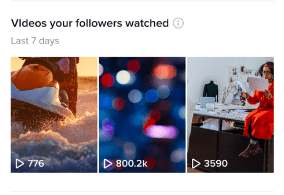


Source: TikTok analytics
The creators of this content may very well be your competition. What are they up to?
Of course, these creators could also be potential collaborators. Is there anyone you might want to partner with to grow both of your audiences?
Look for patterns
Knowing whether each individual video flies or flops is a valuable exercise in itself. But if you really want to take your TikTok game to the next level, you need to look for the patterns and connections behind the data.
For example, if you notice your follower growth rate is significantly higher or lower than usual, narrow the date range of your new followers reporting to look for specific spikes or dips. What happened on that day? Make some notes about what you think might have led to the change.
You won’t necessarily be able to diagnose the situation in the first instance, but the next time you see a similar spike or dip, you might start to spot a pattern. In the meantime, you can test your theories to see if you can recreate success or correct a follower loss.
Over time, you’ll be able to tell what your audience wants to see from you. Give them more of that! Whether it’s how-to videos, product reviews, or stitches, you’ll soon get a sense of what kinds of videos get the most engagement and watch time.
Tip: If people watch a video more than once, they really, really like it (and so will the algorithm). To understand which videos get multiple views, subtract your reached audience from your view count. This gives you an estimate of how many times your video got multiple views.
Evaluate your hashtag and sounds strategies
Use the traffic sources analytics to get a sense of how many people are finding your videos through hashtags or sounds.
Sounds trends change lightning fast, but you can always see which sounds your audience has been listening to in the Followers tab of the native TikTok analytics tool. If you’re not seeing great results from your current sounds strategy, try one of these – but only if you can turn your video around almost right away.
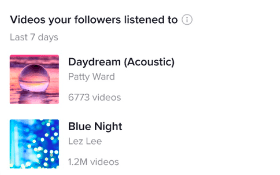


Source: TikTok
For hashtags, pay attention when you see a spike in traffic from hashtags and see if you can narrow it down to a particular hashtag that works well to bring in new viewers. Again, this might take a couple of tries, but over time you should be able to find some consistent winners.
Compare your results to industry benchmarks
The more context you have, the easier it is to understand your results. It’s incredibly helpful to know how the rest of your industry is doing on TikTok, especially during periods of change in activity on your account.
How to see TikTok analytics in the context of your industry as a whole? Hootsuite Analytics has a built-in industry benchmarking report that provides an analysis of how well you’re performing compared to others like you. You can choose the metrics that matter most to you, and select whether to display your data as a chart of a table for ease of use.



Source: Hootsuite Analytics
Don’t forget to have fun
Merriam-Webster’s word of the year for 2023 is “authentic.”
It’s an important reminder for brands that social media – and TikTok in particular – is a place for connection. TikTok is not a billboard, and it’s not even really like other social platforms. It’s a place where authenticity trumps all.
So, use the information from TikTok analytics to hone your strategy, spark content ideas, and understand your audience. But don’t let the numbers be the only thing that guides you. Allow room to experiment authentically and have fun. Just be sure to check your analytics reporting after you do so.
Grow your TikTok presence alongside your other social channels using Hootsuite. Schedule and publish posts for the best times, engage your audience, and measure performance — all from one easy-to-use dashboard. Try it free today.
Grow on TikTok faster with Hootsuite
Schedule posts, learn from analytics, and respond to comments all in one place.



